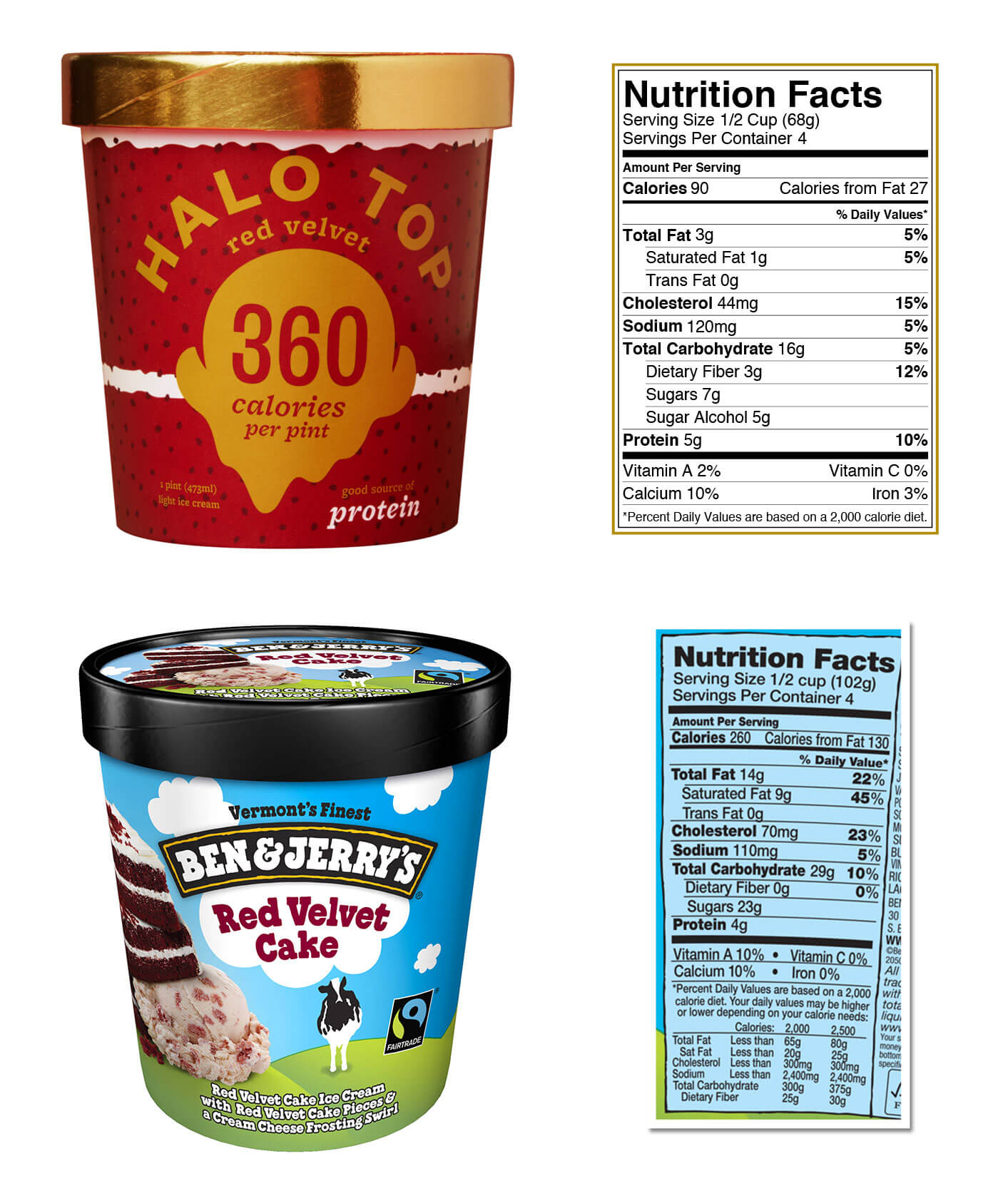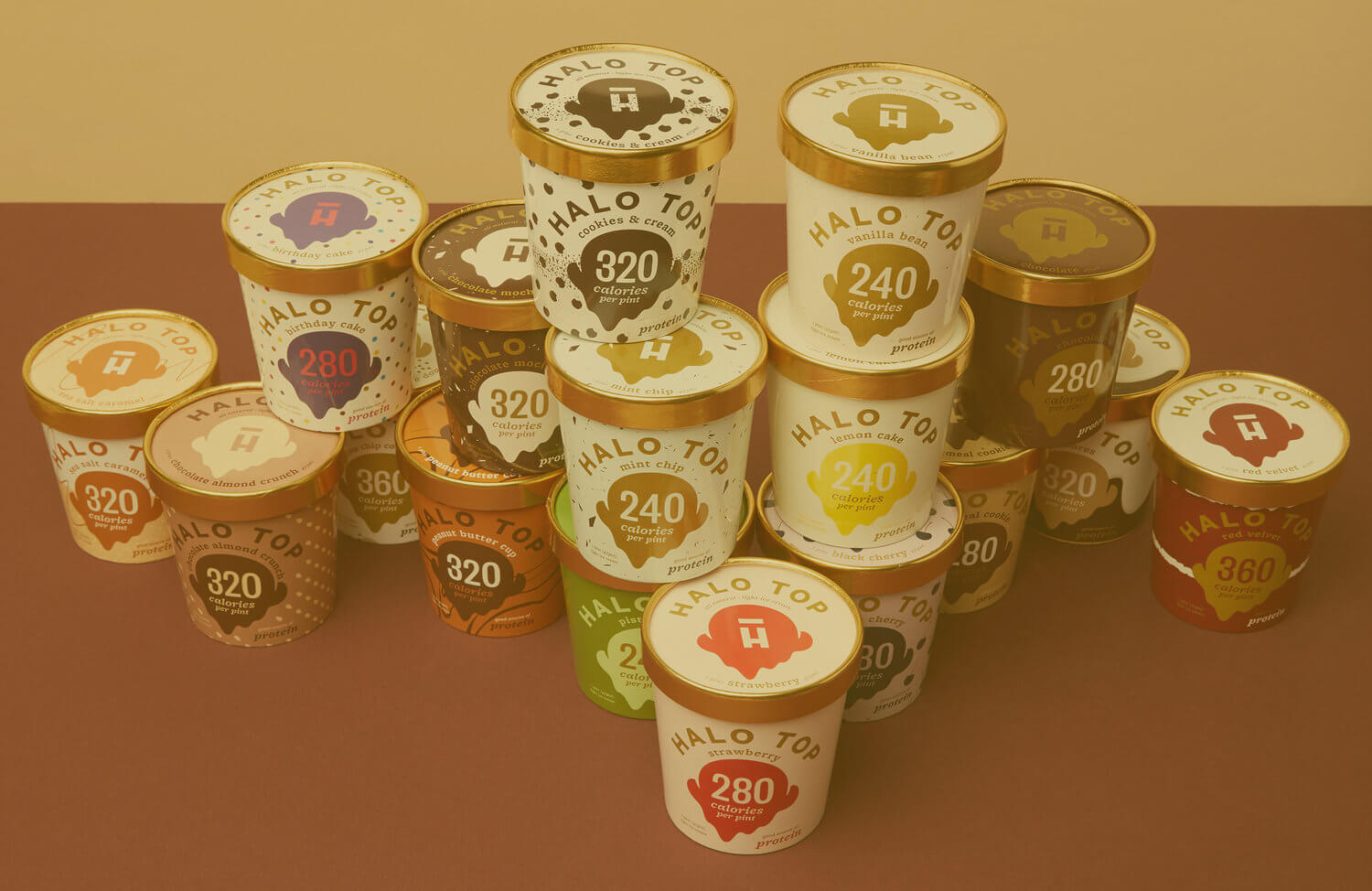Is Halo Top Ice Cream Actually Healthy?

Halo Top ice cream is creating a buzz for its low calorie count, high protein content, and popular flavors. Is it a truly guilt-free way to indulge your summertime cravings, or is it too good to be true? Is Halo Top ice cream actually healthy?
There’s plenty of reasons to be skeptical. If you have any knowledge of the weight loss industry, Halo Top may bring to mind some less-than-ideal diet foods of the past. Remember Snackwell’s, the cookie brand that touted itself as a “healthy choice” because of its low fat content? Well, it turns out they just swapped out fat for sugar, which we now know to be incredibly problematic. What about those Olestra-containing potato chips from the ‘90s? Olestra was praised for being a miraculous calorie-free fat substitute… but it also required a warning label for side effects like abdominal cramping and anal leakage. It’s since been banned in Canada and Europe.
At first glance, Halo Top seems to have more integrity than some of the wonder foods of the past. Let’s take a deeper look.
Nutrition Breakdown: Halo Top vs. Other Premium Ice Creams
At best, eating an entire pint of ice cream is an occasional hedonistic treat. At worst, it’s a classic example of emotional eating. The makers of Halo Top seem to know this: their product is sold in pints, and each one is labeled with the calorie count for the entire container plastered on the front.
Look at the nutrition info and you’ll see a number of glaring differences between Halo Top and the rich dairy desserts it aims to replace. Let’s compare one of the most popular Halo Top flavors (red velvet cake) with a Ben & Jerry’s equivalent.

As advertised, Red Velvet Halo Top is high-protein (20 grams per pint) and its calorie and sugar content pales in comparison to its counterpart. Ben & Jerry’s has 1040 calories and 92 grams of sugar per pint, while Halo Top has 360 calories and 28 grams of sugar per pint.
Halo Top looks much better to the calorie counters among us, and it also seems promising from a macronutrient perspective. So what kind of dairy sorcery is going on here?
Ingredients
The ingredient list gives us a better sense of nutrition quality than the label alone.
Halo Top ingredients (Red Velvet):
Milk and cream, eggs, erythritol, milk protein concentrate, brownie dough (flour [wheat], sugar, butter, cocoa [processed with alkali], soybean oil, white rice flour, vanilla extract, organic soy lecithin, salt), organic cane sugar, prebiotic fiber, high fat cocoa, vegetable glycerin, sea salt, natural flavors, organic carob gum, organic guar gum, organic stevia.
Ben & Jerry's ingredients (Red Velvet Cake):
Cream, skim milk, water, liquid sugar (sugar, water), corn syrup, dried cane syrup, cream cheese (pasteurized milk, cream, cheese culture, salt, carob bean gum, guar gum), wheat flour, egg yolks, cultured lowfat buttermilk, sugar, coconut oil, butter (cream, salt), eggs, vegetable and fruit juice concentrates (color), salt, vanilla extract, guar gum, baking powder (sodium acid pyrophosphate, sodium bicarbonate, corn starch, monocalcium phosphate, calcium sulfate), natural flavors, buttermilk, rice protein concentrate, lactic acid, carrageenan.
Both contain real dairy, some real sugar, naturally-derived flavors, and a number of additives that presumably stabilize texture, consistency, and flavor.
Essentially, Halo Top swaps out high-fat, high-calorie ingredients for more processed ones that look better on a nutritional label. Milk protein concentrate, for example, is a dairy byproduct that is factory-made in a number of ways. It's a popular addition to protein powders and bars, cheese products, and other boxed foods.
Erythritol and stevia are Halo Top's alternatives to sugar, corn syrup, and other caloric sweeteners.  Erythritol is a sugar alcohol that occurs naturally in some foods, but as a food additive, it needs to be produced industrially from genetically modified corn. The good news? It doesn't cause tooth decay or a spike in blood sugar, and it is not usually associated with gastrointestinal distress. The bad news? Its long-term effects are not well-known. Considering that a 2014 study confirmed its function as an insecticide, it's important to understand it may have some nasty side effects we don't know about yet.
Erythritol is a sugar alcohol that occurs naturally in some foods, but as a food additive, it needs to be produced industrially from genetically modified corn. The good news? It doesn't cause tooth decay or a spike in blood sugar, and it is not usually associated with gastrointestinal distress. The bad news? Its long-term effects are not well-known. Considering that a 2014 study confirmed its function as an insecticide, it's important to understand it may have some nasty side effects we don't know about yet.
Stevia, a plant-derived sweetener, is quite similar. It doesn't have the harsh counterindications of aspartame or Olestra, but its safety has been disputed by the FDA and its long-term effects are not well understood.
You may be relieved that none of these ingredients come with a huge red flag. However, it brings to mind a quote:
"Real food doesn't HAVE ingredients. Real food IS ingredients." - Jamie Oliver
Halo Top replaces whole ingredients with processed ones. Yes, this helps make its nutrition facts more favorable, but there's more to eating and nourishment than numbers alone.

The biggest issue with products like Halo Top is that they complicate our relationship with food. These products aren't trying to nourish you. They are trying to give you a free pass to eat emotionally and mindlessly. More than trying to fuel your body, Halo Top wants to relieve your guilt.
Should you eat it or not?
Our experts weigh in. "I believe in eating nourishing foods and eating for satisfaction," says Kate Hannon, Director of Integrated Wellbeing. "If Halo Top hits both of those for you, then great." After all, dessert is part of life. We are hardwired to love it – it lights up the brain's reward center and brings us comfort. "But if food is the only thing that we turn to for comfort, then it's time to pay attention," says Kate.
The message, then, is that Halo Top itself isn't inherently good or bad. However, it does encourage us to abandon our awareness – which is one of the biggest issues with how we eat today.
If you decide to dig into some Halo Top (or any other indulgence) then take Kate's advice: "Stay connected to how it feels in your body. Are you eating the whole pint because 'it's only 360 calories' or because you actually want it? Stay connected to how full you are. Put the spoon down halfway through and check in with yourself. Take a sip of water. Are you still hungry? Do you even taste it anymore?"
Eleni Ottalagana, Skyterra's Director of Nutrition Services, echoes Kate's sentiments and offers some better real-food alternatives. To eat mindfully and without guilt, "Enjoy something real, in a pleasurable moment, in a small quantity," she says. "Instead of consuming chemicals to trick our bodies into thinking we've had the real thing, have something natural and real. Blend up a delicious homemade 'ice cream' from a frozen banana, raw cacao, and a small spoonful of nut butter. Or even have a small amount of local ice cream with minimal, high-quality ingredients."
Ultimately, the way we eat is just as important as what we eat. Developing an intuitive eating practice is an essential part of nourishing ourselves and maintaining a healthy weight.
While Halo Top might have a better nutritional profile than some other junk foods, it encourages mindless eating. This kind of disconnection is one of the biggest challenges in our diets today.